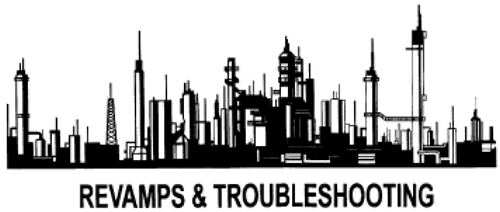|
|
PREFACE...........................................................................................................................................
|
X |
|
|
|
|
1
|
What is a Process Design?.....................................................................................................................
|
1 |
|
|
The Elements of a Process Design Package. Process Description. Overall Material Balance. Process Flowsheet. Composition Summary. Line List. Heat Exchanger Specifications. Pump Data. Fired Heater Data Sheets. Vessel Sketches. Tray Data Sheets. Compressor Data Sheet.
|
|
2
|
Packed Column Pitfalls ........................................................................................................................
|
6 |
|
|
Structured Packing. Rings Versus Structured Packing. Migrating Rings. Designing Tower Internals. Support Grid. Other Ideas to Increase the Capacity of Packed Towers. Hold-Down Grids. Vapor Distributor. Liquid Distribution and Collection. Propylene-Isobutane Splitter. References.
|
|
3
|
Vacuum Tower Design..........................................................................................................................
|
27 |
|
|
Wash-Oil Section Design. Flash-Zone Temperature. Pumparound Design. Tower Top Temperature. Wet Versus Dry Towers.
|
|
4
|
Trayed Tower Internals ........................................................................................................................
|
38 |
|
|
Avoid Internal Level Connections. The Dangers of Internal Draw-Off. Overflowing Draw-Off Sumps. Coordinating Nozzle Location with Tray Design. Feed and Reflux Distributors. Never Seal a Downcomer. Side-Stream Steam-Stripper Hydraulics. Combination Pumparound Draw-Off and Product Trap-Out Pan. Leak-Proofing Draw-Off Pans. Strengthening Trays to Withstand Pressure Surges. Vacuum Tower Trap-Out. Tray Leakage. Chimney Tray Design. Reviewing Vendor Tray Drawings. References.
|
|
5
|
Washing Flash-Zone Vapors .................................................................................................................
|
57 |
|
|
Choice of Wash-Oil Internals. Bubble-Cap Trays. Valve Trays. Shed Decks or Side-to-Side Baffles. Demisters. Ring Packing. Washing-Oil Grid.
|
|
6
|
Revamping Distillation Columns ..........................................................................................................
|
61 |
|
|
Tower Capacity. Trayed Towers. Packed Towers. Overhead Condensers. Fin-Tube Exchangers. Reboilers. Optimum Reboiler Retrofit. Energy Savings. High-Flux Tubing. Errors Made in Revamping Distillation Columns. Reference.
|
|
7
|
Distillation Tower Reboiler Details........................................................................................................
|
83 |
|
|
Kettle Reboilers. Thermosiphon Reboilers.
|
|
8
|
Sizing Vessels .......................................................................................................................................
|
91 |
|
|
Sizing the Boot. Hydrocarbon-Water Separation. Inlet Piping Design. Flooded Condenser Reflux Drum. Liquid Hold time. Vapor-Liquid Separators. Horizontal Vapor-Liquid Separators. Hydrocarbon Skimming Vessel.
|
|
9
|
Steam Turbines and Surface Condensers ..............................................................................................
|
101 |
|
|
Topping Steam Turbine Drives. How Steam Turbines Function. An Energy Conservation Incident. The Vacuum-Jet System. Condensate Pumpout System. Surface Condenser. An Unusual Incident. Reference.
|
|
10
|
How to Pull a Deep Vacuum ................................................................................................................
|
121 |
|
|
Steam Pressure Affects Vacuum. Jet Capacity. Seal Leg Design. Design of Seal Drums. Tail-Gas Quantity. Disposal of Ejector Tail Gas. Liquid Seal Ring Compressors. References.
|
|
11
|
Centrifugal Compressors: Designing to Avoid Surge .............................................................................
|
135 |
|
|
Reciprocating Compressors. Centrifugal Compressor Characteristics. What Is Surge? What Causes Surge? Variable Molecular Weight. Compression Work. Practical Problems of Variable Molecular Weight. Adjusting for Low Molecular Weights. Maximum Number of Wheels. Allowing for High Molecular Weight. Suction Throttling. References.
|
|
12
|
Sizing Centrifugal Pumps ...................................................................................................................
|
143 |
|
|
How Much Head Is Required? How Much Flow Is Required? Selecting a Pump's Impeller. Selecting a Pump's Motor. Shut-In Pressure. Expanding Pumping Capacity. Reducing Hydraulic Bottlenecks. Larger Impeller. Correct Process Design Minimizes Pump Maintenance. Protecting Against Low NPSH.
|
|
13
|
Shell-and-Tube Heat Exchangers - The Pitfalls of Oversizing ..............................................................
|
153 |
|
|
Three Feet Per Second. Calculating. Tube-Side Velocity. How to Design for High Tube-Side Velocity. Calculating Shell-Side Velocity. Fouling Factors. Tube Configuration. Revamp Errors Made in Expanding Condensers. Reboiler Design Errors. References.
|
|
14
|
Fired Heater Design for Maximum Run Lengths .................................................................................
|
175 |
|
|
Mass Velocity. Velocity Steam. Heat Flux. Uneven Heat Distribution. Air Preheater - Effect on Radiant Heat Flux. Burning Waste Gas. Convective Section. Soot Blowers. Finned Versus Studded Tubes. Afterburn in Convective Sections. Metallurgy of Tubes. Auxiliary Drums. References.
|
|
15
|
Corrosion Control Techniques .............................................................................................................
|
188 |
|
|
Controlling Condensate pH in Crude Oil Distillation. Equipment Sizing. Dead Ends. Water Accumulation Can Cause Hydrogen Blistering of Steel. Draining Small Amounts of Water Continuously. Carbon Dioxide in Steam Is Corrosive. Use Corrosion to Prevent Corrosion. Sacrificial Anode. Excessive Velocity Erosion. References.
|
|
16
|
Safety .................................................................................................................................................
|
200 |
|
|
Startups and Shutdowns. Hazards of Water. Dehydrating by Circulation. Fluctuating Feed. Water in Feed. Electric Power Failure. Loss of Cooling. Instrument Air Failure. Level Control. Anticipating Heat Exchanger Leaks. Vessel Collapse. A Word of Caution. References.
|
|
17
|
Liquid Level Control ..........................................................................................................................
|
212 |
|
|
Level Indication. Redundancy in Liquid Level Indication. Other Methods of Liquid Level Measurement. Minimizing Level Tap Plugging. References.
|
|
18
|
Saving Energy Through Flexibility .....................................................................................................
|
220 |
|
|
Turndown in Distillation. Dual Reflux Distributors. Turndown in Trayed Columns. Dual-Cap Valve Trays. Adjustable Weirs. Avoid Leaking Trays. Fired Heaters. Air Preheaters. Heat Exchangers. Laminar Flow. Centrifugal Pumps. Flexibility Items Which Waste Energy. Reference.
|
|
19
|
Cost Estimate - How to Allow For Installation Factors ........................................................................
|
229 |
|
|
Installation Costs. Installation Costs for Individual Process Items. Utilizing Used Equipment. Major Plant Costs. References.
|
|
20
|
Flowing Steam………………………………………………………...........................................................
|
235 |
|
Reducing Moisture Content of Steam, Vacuum Jets, Turbines, and Superheat Coils. Use of Mollier Diagram.
|
|
21
|
Process Control Concepts…….………………………………………........................................................
|
244 |
|
Turbine Driven Pumps, Fired Heater Excess Air, Distillation Tower Pressure Control.
|
|
|
|
|
Appendix ……………………………………………………………......................................................... |
252 |
|
Some more methods to improve mechanical integrity of trays |
|
|
|
|
|
GLOSSARY .......................................................................................................................................
|
256 |
|
|
|
|
|
INDEX ................................................................................................................................................
|
264 |


